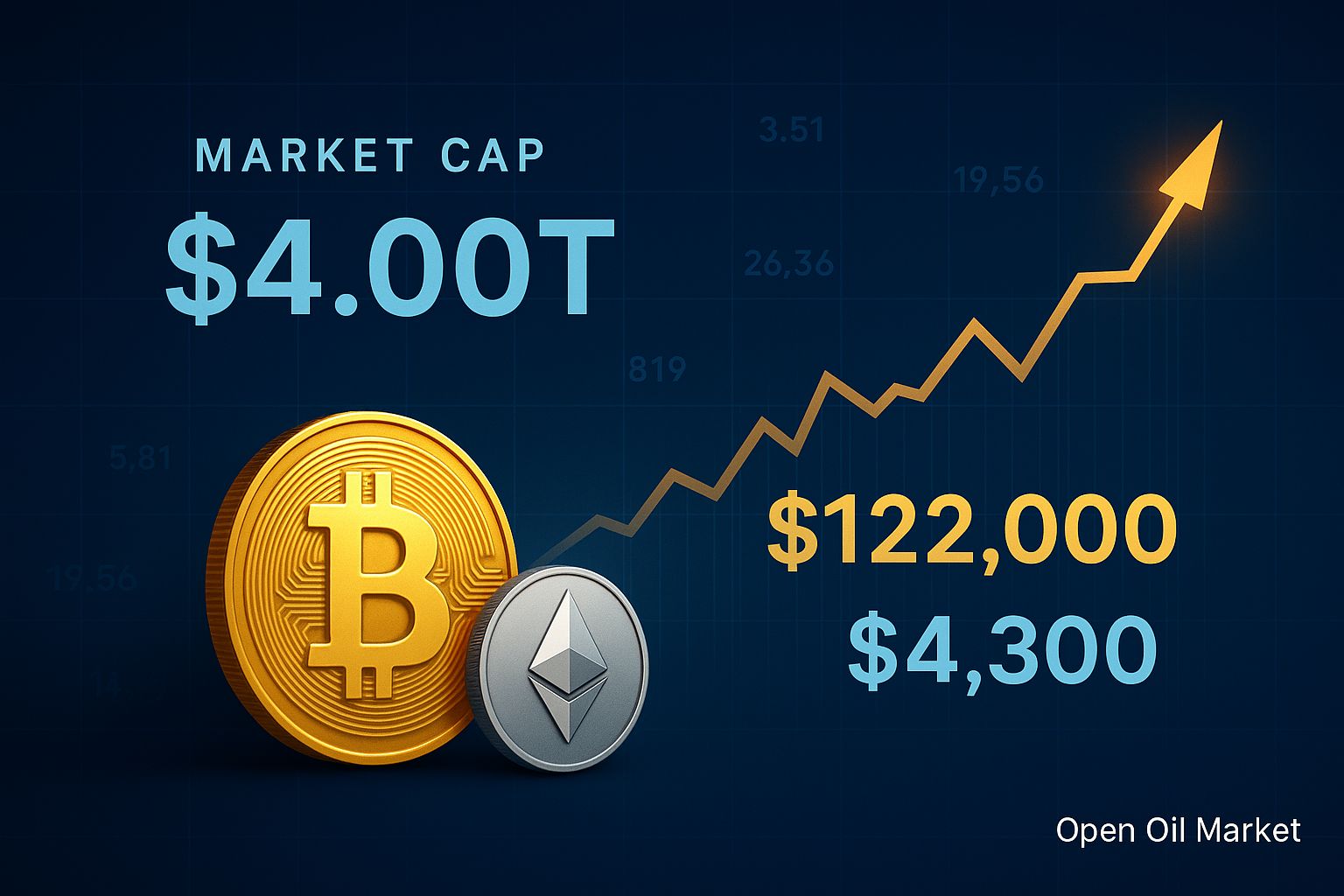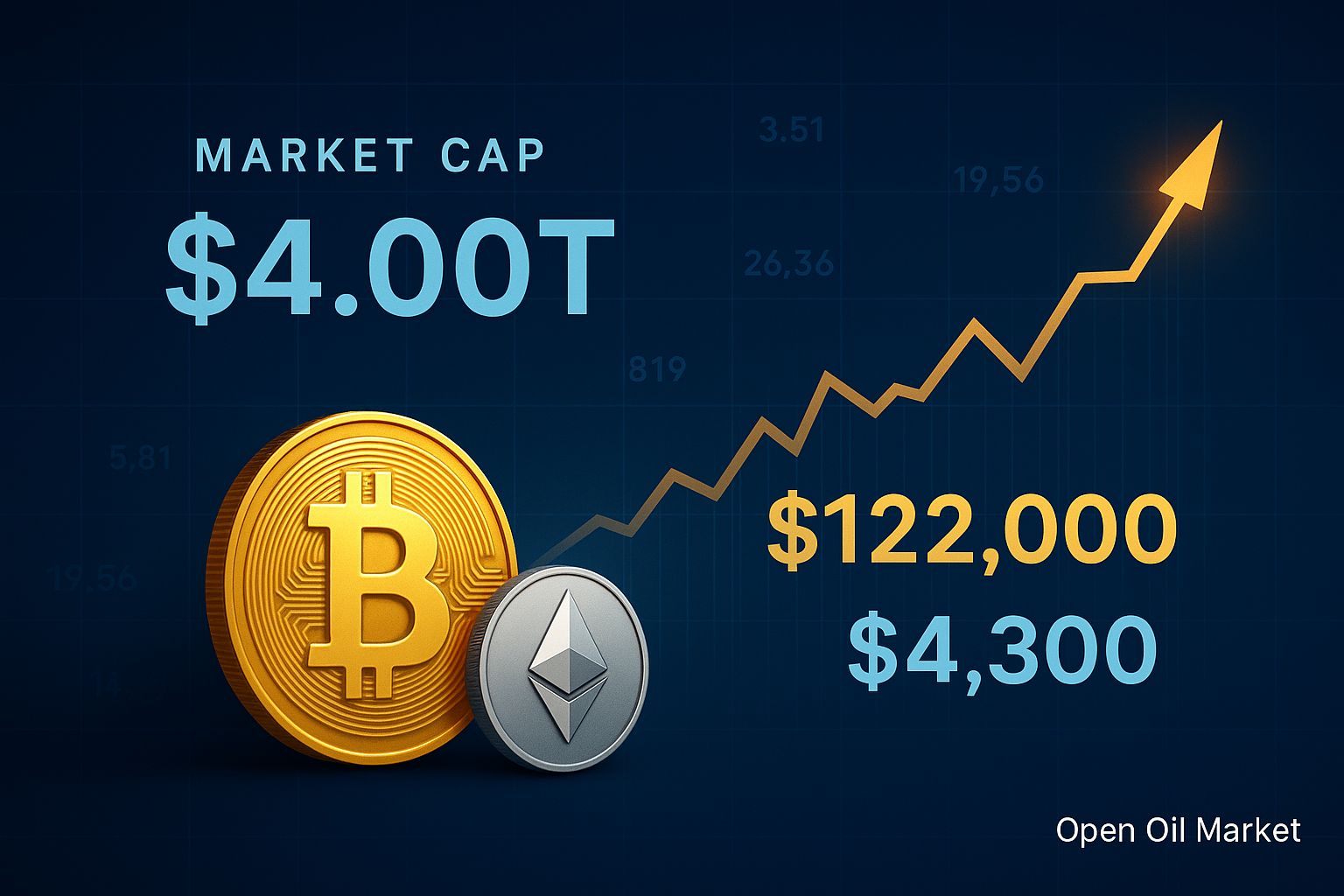
The Crypto Market Reaches a Record $4 Trillion: Bitcoin Rises to $122,000, Ethereum Surpasses $4,300. Analyzing Market Structure, Growth Factors, and Risks for Investors.
The cryptocurrency market has reached a historic milestone: the total capitalization of all crypto assets has exceeded $4 trillion. Riding on this wave of growth, the market leader Bitcoin (BTC) on August 11 surged to $122,000, coming close to its all-time high recorded on July 14. Ethereum (ETH) is also showing robust growth, exceeding the $4,300 mark for the first time in 2025. These impressive figures reflect heightened investor interest in the cryptocurrency market and the solidification of digital currencies as a legitimate asset class.
Bitcoin on the Brink of a New Record
The value of Bitcoin is skyrocketing, with current levels approaching historical peaks. After breaching the psychologically significant threshold of $120,000, Bitcoin is nearing the highs set in previous years. The prior record was established in July 2025 at approximately $123,000, and now BTC is trading within the same ranges. Bitcoin's market capitalization has reached about $2.43 trillion, accounting for roughly 60% of the entire cryptocurrency market. This dominant weight reinforces BTC's status as "digital gold" and serves as a primary benchmark for investors in the crypto space.
The Ethereum Surge and Its Significance
The second-largest crypto asset, Ethereum, is steadily rising in tandem with Bitcoin. Surpassing the $4,300 mark, Ethereum has reached a new high for the year, with its market capitalization climbing to $518 billion (around 13% of the total market capitalization). The rise of Ethereum is attributed not only to overall market sentiment but also to fundamental factors: the active use of the Ethereum network in decentralized finance (DeFi), smart contracts, and the issuance of stablecoins. Network improvements (transitioning to Ethereum 2.0 with a Proof-of-Stake mechanism) have also bolstered investor confidence, reflected in price dynamics. Ethereum continues to be a key platform for innovations in the blockchain ecosystem, and the increase in its value signals strong demand for related technologies.
Market Structure: Bitcoin, Ethereum, and Stablecoins
The record capitalization of the cryptocurrency market at $4 trillion is distributed unevenly across assets. Bitcoin remains leader with approximately 60% market share. Ethereum holds second place with around 13%. Notably, the presence of stablecoins among the largest assets is significant: for instance, Tether's (USDT) capitalization stands at about $164 billion (around 4% of the market). Stablecoins—tokens pegged to the dollar—play a vital role in providing liquidity and serving as an intermediary in cryptocurrency trading. The remaining part of the market (roughly 20–22%) comprises hundreds of other crypto assets, including major altcoins, yet none approach the scale of Bitcoin or Ethereum. The dominance of leading coins indicates that the bulk of capital is concentrated in the most established and liquid assets.
Growth Factors: From Regulation to Demand
The surge in cryptocurrency market capitalization is driven by a combination of factors:
- Regulatory Clarity. Clear rules for digital assets are being established in key countries: in the U.S., for example, legislation on stablecoins and other cryptocurrencies has been passed, boosting confidence among major players.
- Institutional Demand. Major financial firms and funds are increasing their investments in cryptocurrencies, seeking to diversify portfolios and keep pace with emerging trends.
- Macroeconomic Conditions. High inflation and volatility in traditional markets enhance Bitcoin's appeal as "digital gold" and a means of capital preservation.
- New Products and Technologies. The launch of exchange-traded funds (ETFs) based on Bitcoin and Ethereum, improvements in blockchain protocols, and the development of DeFi expand opportunities for market participants and attract new investors.
Institutional Investments and New Financial Products
The influx of institutional capital deserves special attention. In recent months, the market has seen the entry of major players—from hedge funds to corporate treasuries. The emergence of exchange-traded funds (ETFs) for Bitcoin and Ethereum has provided traditional investors with a convenient tool for accessing cryptocurrencies. According to industry reports, over $500 million in new investments flowed into Bitcoin ETFs in the first half of August alone, spurring growth in prices. Additionally, some public companies have announced investing part of their reserves in Bitcoin, following the footsteps of Tesla and MicroStrategy from previous years. The introduction of such institutional products increases liquidity and enhances trust in digital assets among conservative investors.
Risks and Volatility in a Record Market
The rapid growth of the cryptocurrency market undoubtedly attracts attention, but it is also accompanied by increased volatility. Investors should keep in mind that after a swift rise, sharp corrections are equally possible. The cryptocurrency market has historically demonstrated cyclicality: periods of rapid growth are often followed by retracements. Additional risk stems from regulatory uncertainty in some countries and the potential tightening of rules—despite progress in several jurisdictions, the global regulatory environment remains uneven. Moreover, the concentration of a significant portion of the market in Bitcoin means that any major event impacting BTC (e.g., security network news or large-scale sell-offs) can reverberate across the entire ecosystem. High market capitalization valuations may attract new competitors and uncover technological vulnerabilities (e.g., risks in DeFi smart contracts). In such conditions, it is crucial for investors to remain cautious and maintain a long-term perspective, resisting the market's euphoria.
What This Boom Means for Investors
The current boom in the cryptocurrency market presents new opportunities for investors, but it also requires a measured approach. On one hand, the record capitalization confirms that cryptocurrencies have solidified their place in the global financial system — they are becoming increasingly difficult to ignore when diversifying portfolios. Many market participants, previously skeptical, are now viewing Bitcoin and Ethereum as serious long-term investments. On the other hand, the high market valuation necessitates caution: before entering positions at peak levels, it is important to objectively assess one's risk tolerance and investment horizons.
In such conditions, experts recommend adhering to several key principles:
- Diversification of the Portfolio. Crypto assets should not represent an excessively large share of investments; a balanced portfolio will mitigate the impact of potential drawdowns in individual assets.
- Risk Management. Only invest in cryptocurrencies with funds that one can afford to lose. It is essential to set loss limits and refrain from succumbing to emotions during market fluctuations.
- Informed Decisions. Continuously monitor fundamental events: news about regulations, technological updates to blockchain platforms, and the launch of new products. Current information will help react promptly to market changes.
- Long-Term Approach. Plan investments for the long term, avoiding the temptation to get rich quickly. History shows that patience and the “buy and hold” strategy often pay off in the volatile crypto market.
Adhering to these principles, supported by personal research and market understanding, will enable investors to capitalize on new opportunities in the crypto industry while simultaneously limiting potential risks.
Prospects and Predictions
Experts agree that establishing the $4 trillion threshold is merely a stage in the industry's development. Optimistic projections suggest the potential for further growth: several analysts from major investment firms do not rule out the possibility of Bitcoin's price reaching $150,000–200,000 by the end of the year if current trends continue. Ethereum, according to some experts, is capable of securing itself above historical highs as the application of its blockchain expands across various sectors of the economy. However, corrections are also possible: such rapid growth in capitalization may slow down if investors begin to take profits or if macroeconomic conditions worsen. Nevertheless, the long-term trend remains positive—cryptocurrencies are increasingly integrating into the financial system, and innovations in this field are attracting both retail and institutional investors. The record of $4 trillion serves as a signal of the market's maturation, and further dynamics will largely depend on how successfully the industry can tackle the challenges of growth and meet the expectations placed upon it.




